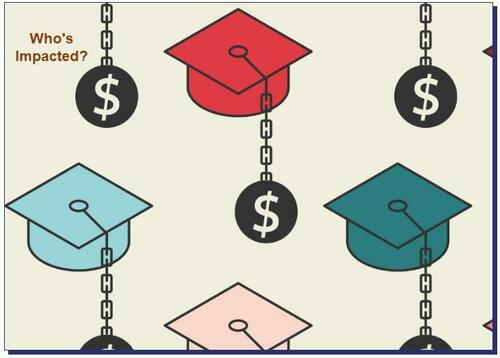The Complicated Mess To Restart Student Loan Payments Is On Purpose
Authored by Mike Shedlock via MishTalk.com,
President Biden does not want student loan payments to start. The easiest way is to make it an understaffed, complicated mess…
Purposeful Student Loan Mess
Interest on student loans restarts on September 1 with payments starting in October. Few are prepared. If you are a student with questions, good luck getting answers.
And who is the servicer one needs to call?
Transferred to a New Servicer
About four-in-10 borrowers’ loans transferred to a new servicer during the pause that began in March 2020, according to government data.
Why was anyone transferred to a new servicer when literally nothing was getting serviced?
Borrowers Confused by Complicated Process
The Wall Street Journal reports Student Loans Are Emerging From Deep Freeze, and Borrowers Are Confused
‘Most complicated process I’ve ever been involved in’
Geri Critchley, a 75-year-old former nonprofit employee, is among those attempting to navigate the system. She paid graduate-school loans for more than 20 years. She has $14,000 left, but no clarification as to what she will owe each month and how to pay.
After three years of no payments, she called her loan servicer and the Education Department to ask about forgiveness options, payment deadlines and amounts. But getting through to a human at each place took some work. Critchley encountered what many borrowers fear: long hold times, constant redirections and dropped calls. When she finally got through to her loan servicer, the voice on the other end of the line suggested she call back in January when call volume would be lower—three months after repayment is set to start.
“The Department of Education person said to me, ‘I’ve been working in this field for many years, and I admit it’s the most complicated process I’ve ever been involved in,’ ” Critchley said.
Beyond answering questions about the payment restart, servicers also advise borrowers about complex financial decisions such as whether to consolidate loans or enroll in the income-driven program, called Saving on a Valuable Education, or SAVE.
A complication for the administration is that some features of the plan, such as cutting monthly payments from 10% to 5% of discretionary income, won’t be available until next summer, after the regulatory process concludes.
“A lot of folks just have no idea where to start,” said Meagan McGuire, a consultant at Student Loan Planner, a financial-advisory firm. “With the website and servicers not being super helpful right now, that’s leading to more confusion—newer borrowers are just throwing their hands up.”
Call Back in January
“Call back in January” but payments start in October. What a hoot.
Why any of this is complicated would normally be a mystery. But 1) we are talking about the government and 2) the last thing Biden wants is for a smooth restart.
If it’s complicated, it’s complicated on purpose. Who picked the start date for SAVE?
Biden does not want payments to start at all. And the bigger the mess, the more he is likely to extend forgiveness for as long as he can, by decree of course.
Urging Biden to Ignore the Supreme Court
The Journal notes “Senate Majority Leader Chuck Schumer, wrote to Biden last week about their repayment concerns and urged him to try again on mass cancellation using other legal authorities.”
There are no other legal authorities and even Nancy Pelosi understood that.
Who’s Impacted?
More than 16 million borrowers who thought their loans would be forgiven have to repay.
Please consider Who’s Impacted by the Supreme Court’s Student-Loan Forgiveness Ruling
Once payments resume, the typical student-loan payment will be between $210 and $314 a month, according to a new report from Wells Fargo. Overall, more than 40 million borrowers would have qualified for loan forgiveness through a required application. Before legal challenges halted the plan, borrowers in every state were approved for loan cancellation. Big states such as California, Texas, Florida and New York had the most approvals overall. The District of Columbia had the most approvals in proportion to its adult population, followed by Georgia and Ohio.
That’s a free link courtesy of the WSJ. It contains lots of charts on the 43 million people who collectively owe $1.6 trillion in federal student-loan debt as of March 31.
* * *
Tyler Durden
Mon, 08/28/2023 – 14:25
via ZeroHedge News https://ift.tt/y5T6Zhi Tyler Durden
